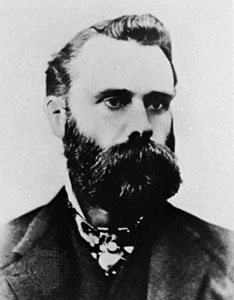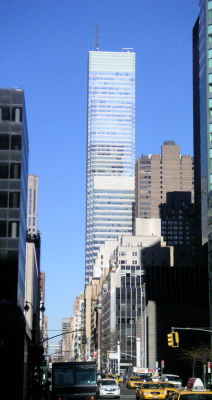
Dow Jones & Company, Inc. is an American publishing firm owned by News Corp and led by CEO Almar Latour.

Charles Henry Dow was an American journalist who co-founded Dow Jones & Company with Edward Jones and Charles Bergstresser.

Bloomberg L.P. is a privately held financial, software, data, and media company headquartered in Midtown Manhattan, New York City. It was co-founded by Michael Bloomberg in 1981, with Thomas Secunda, Duncan MacMillan, Charles Zegar, and a 12% ownership investment by Bank of America through their brokerage subsidiary Merrill Lynch.

The Bloomberg Terminal is a computer software system provided by the financial data vendor Bloomberg L.P. that enables professionals in the financial service sector and other industries to access Bloomberg Professional Services through which users can monitor and analyze real-time financial market data and place trades on the electronic trading platform. It was developed by employees working for businessman Michael Bloomberg. The system also provides news, price quotes, and messaging across its proprietary secure network. It is well known among the financial community for its black interface, which has become a recognizable trait of the service. The first version of the terminal was released in December 1982.
A Refinitiv Identification Code, or RIC, is a ticker-like code used by Refinitiv to identify financial instruments and indices. The codes are used for looking up information on various Refinitiv financial information networks and appear to have developed from the Quotron service purchased in the 1980s.

A trading room gathers traders operating on financial markets. The trading room is also often called the front office. The terms "dealing room" and "trading floor" are also used, the latter being inspired from that of an open outcry stock exchange. As open outcry is gradually replaced by electronic trading, the trading room becomes the only remaining place that is emblematic of the financial market. It is also the likeliest place within the financial institution where the most recent technologies are implemented before being disseminated in its other businesses.

Louis Gordon Crovitz is an American media executive and advisor to media and technology companies. He is a former publisher of The Wall Street Journal who also served as executive vice-president of Dow Jones and launched the company's Consumer Media Group, which under his leadership integrated the global print, online, digital, TV and other editions of The Wall Street Journal, MarketWatch.com and Barron's across news, advertising, marketing and other functions. He stepped down from those positions in December 2007, when News Corp. completed its acquisition of Dow Jones. He writes a weekly column in The Wall Street Journal, titled "Information Age."

CME Group Inc., headquartered in Chicago, operates financial derivatives exchanges including the Chicago Mercantile Exchange, Chicago Board of Trade, New York Mercantile Exchange, and The Commodity Exchange. The company also owns 27% of S&P Dow Jones Indices. It is the world's largest operator of financial derivatives exchanges. Its exchanges are platforms for trading in agricultural products, currencies, energy, interest rates, metals, futures contracts, options, stock indexes, and cryptocurrencies futures.

Marex is a UK-based diversified global financial services platform, connecting clients to global energy, metals, agricultural and financial markets. Across its businesses, Marex provides high value add services in Market Making, Execution and Clearing, Hedging and Investment Solutions, Price Discovery and Data & Advisory.

Verisk Analytics, Inc. is an American multinational data analytics and risk assessment firm based in Jersey City, New Jersey, with customers in insurance, natural resources, financial services, government, and risk management sectors. The company uses proprietary data sets and industry expertise to provide predictive analytics and decision support consultations in areas including fraud prevention, actuarial science, insurance coverage, fire protection, catastrophe and weather risk, and data management.
A financial data vendor provides market data to financial firms, traders, and investors. The data distributed is collected from sources such as stock exchange feeds, brokers and dealer desks or regulatory filings.
FXCM, also known as Forex Capital Markets, is a retail foreign exchange broker for trading on the foreign exchange market. FXCM allows people to speculate on the foreign exchange market and provides trading in contract for difference (CFDs) on major indices and commodities such as gold and crude oil. It is based in London.

Neil S. Hirsch was an American businessman and entrepreneur. In 1969, he founded Telerate, a global communications network. In addition, he was the owner of Loanet and the patron of the BlackWatch Polo Team.

BGC Partners is an American global financial services company based in New York City and London. Originally formed as part of the larger Cantor Fitzgerald organization, BGC Partners became its own entity in 2004.
Bridge Information Systems was a financial news and data provider that was acquired by Reuters Group in September 2001.

Timothy Charles Slater, known as "Tim", is an American entrepreneur and trader who founded CompuTrac, the first software program to draw commodity graphs and technical market indicators on a personal computer, in 1978. Slater contributed significantly to the field of technical analysis as a way to uncover price movements and trends.

Quotron was a Los Angeles-based company that in 1960 became the first financial data technology company to deliver stock market quotes to an electronic screen rather than on a printed ticker tape. The Quotron offered brokers and money managers up-to-the-minute prices and other information about securities. The Quotron was developed by Scantlin Electronics, owned by entrepreneur John Scantlin. Scantlin had earlier developed a quotation device that used magnetic tape instead of ticker tape. Quotron's first major competitor was Telerate, which was founded by Neil Hirsch in 1969 and later bought by Dow Jones in 1990.
Alexander Forbes Group Holdings, commonly referred to as Alexforbes is a diversified financial services organisation. The company is headquartered in Johannesburg, South Africa, with a presence in two other countries on the African continent: Namibia and Botswana and in the Channel Islands through an offshore Jersey operation.

Interactive Brokers LLC (IB) is an American multinational brokerage firm. It operates the largest electronic trading platform in the United States by number of daily average revenue trades. The company brokers stocks, options, futures, EFPs, futures options, forex, bonds, funds, and some cryptocurrencies.

Citadel Securities is an American market making firm headquartered in Miami. It is one of the largest market makers in the world, and is active in more than 50 countries. It is the largest designated market maker on the New York Stock Exchange. Citadel Securities is a separate entity from the hedge fund Citadel LLC, although both were founded and are majority owned by American hedge fund manager Kenneth C. Griffin. Citadel Securities is expected to eventually move its headquarters from Chicago to Miami, having bought land there to build its new headquarters.















